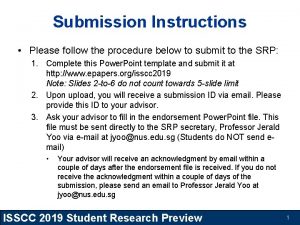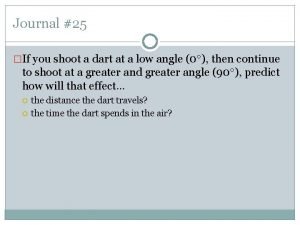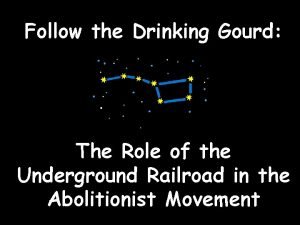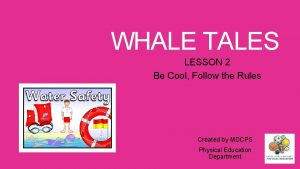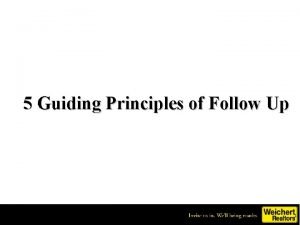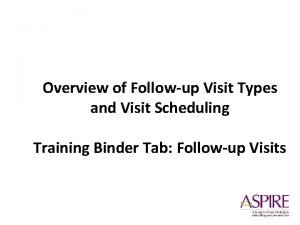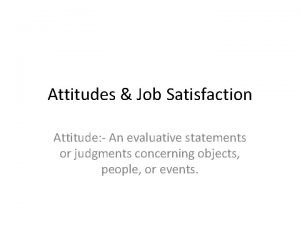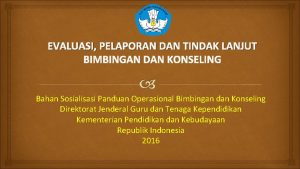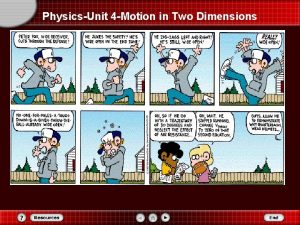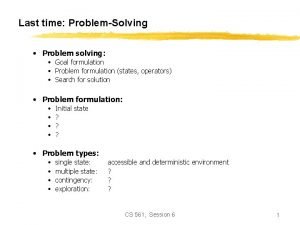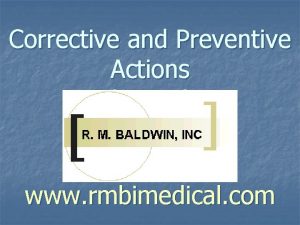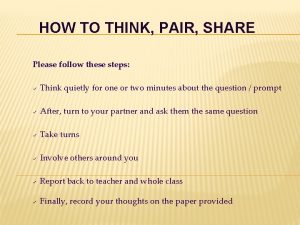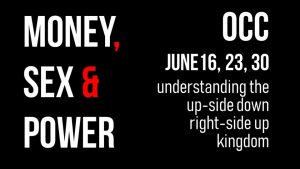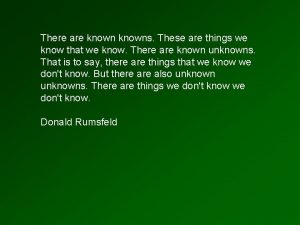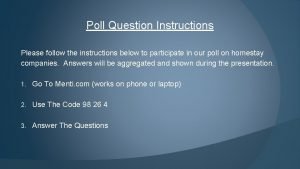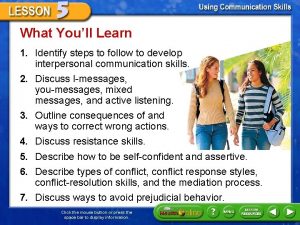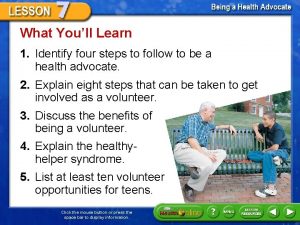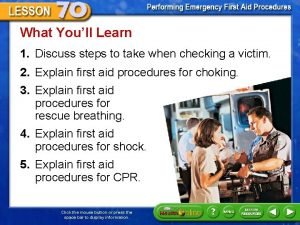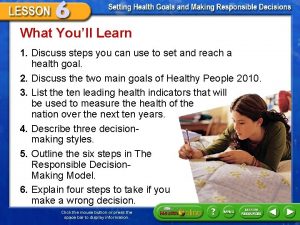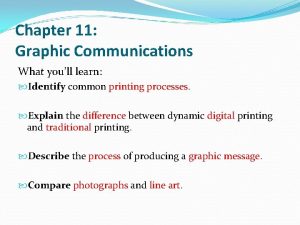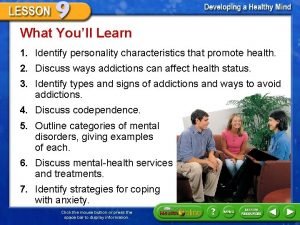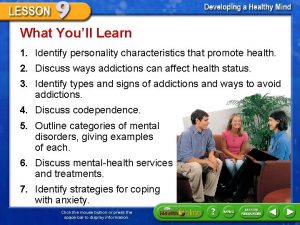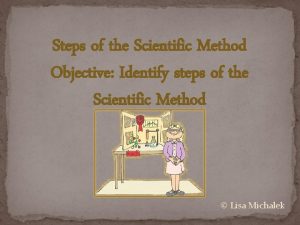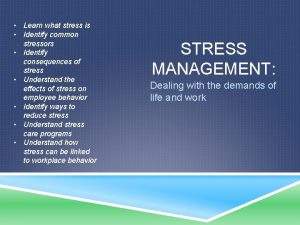What Youll Learn 1 Identify steps to follow





























































- Slides: 61

What You’ll Learn 1. Identify steps to follow to develop interpersonal communication skills. 2. Discuss I-messages, you-messages, mixed messages, and active listening. 3. Outline consequences of and ways to correct wrong actions. 4. Discuss resistance skills. 5. Describe how to be self-confident and assertive. 6. Describe types of conflict, conflict response styles, conflict-resolution skills, and the mediation process. 7. Discuss ways to avoid prejudicial behavior. Click the mouse button or press the space bar to display information.

Key Terms • communication skills • I-message • you-message • active listening • peer pressure • resistance skills • assertive behavior • conflict-resolution skills • mediation • prejudice Click the mouse button or press the space bar to display information.

Communications Skills • Communication skills are skills that help a person share feelings, thoughts, and information with others. Click the mouse button or press the space bar to display information.

How to Use Interpersonal Communication Skills 1. Choose the best way to communicate. – Your choices for how you communicate with others are almost unlimited. – How you communicate may depend on what you are trying to say. Click the mouse button or press the space bar to display information.

How to Use Interpersonal Communication Skills 1. Choose the best way to communicate. – To send a strong message you may combine verbal and nonverbal communication— the use of actions or body language to express emotions and thoughts. Click the mouse button or press the space bar to display information.

How to Use Interpersonal Communication Skills 2. Express your thoughts and feelings clearly. – An I-message expresses your feelings or thoughts on a subject. – I-messages contain a specific behavior or event, the effect of the behavior or event on the person speaking, and the emotions that result. Click the mouse button or press the space bar to display information.

How to Use Interpersonal Communication Skills 2. Express your thoughts and feelings clearly. – A you-message is a statement that blames or shames another person. – A you-message puts down another person for what he or she has said or done, even if you don’t have the whole story about what happened. Click the mouse button or press the space bar to display information.

How to Use Interpersonal Communication Skills 2. Express your thoughts and feelings clearly. – Using I-messages is more effective than using you-messages and helps maintain healthy relationships with others. – Avoid sending a mixed message—a message that gives two different meanings. Click the mouse button or press the space bar to display information.

How to Use Interpersonal Communication Skills 3. Listen to the other person. – Listening carefully is just as important as speaking clearly. – Maintain eye contact and use gestures, such as nodding your head, to encourage conversation. Click the mouse button or press the space bar to display information.

How to Use Interpersonal Communication Skills 3. Listen to the other person. – Pay attention to the speaker’s body language and tone to see if he or she might be sending a mixed message. – When you show a speaker respect, you will have more effective conversations. Click the mouse button or press the space bar to display information.

How to Use Interpersonal Communication Skills When You Don’t Listen You may tune out because you: • were thinking of something or someone else. • were thinking about what you were going to say next. • could not hear the speaker. • heard a distracting noise in the room. • were tired and dozing off while the other person was talking. • thought you knew what the speaker was going to say next. Click the mouse button or press the space bar to display information.

How to Use Interpersonal Communication Skills 4. Make sure you understand each other. – Active listening is the way you respond in conversation to show that you hear and understand what the speaker is saying. – Active listening includes clarifying, restating, summarizing, or affirming what was said. Click the mouse button or press the space bar to display information.

How to Use Interpersonal Communication Skills Techniques for Active Listening • Clarifying a response Ask the speaker for more information. • Restating a response Repeat what you think the speaker has said. • Summarizing a response Summarize the main idea the speaker has stated. • Affirming a response State your appreciation for what the speaker has said. Click the mouse button or press the space bar to display information.


Peer Pressure • Peer pressure is the influence that people of similar age or status place on others to behave in a certain way. • Peer pressure can be either positive or negative, and it can be exerted consciously or unconsciously. Click the mouse button or press the space bar to display information.

How to Recognize Types of Peer Pressure • Peer pressure can be positive. – Positive peer pressure is influence from peers to behave in a responsible way. • Peer pressure can be negative. – Negative peer pressure is influence from peers to behave in a way that is not responsible. Click the mouse button or press the space bar to display information.

How to Recognize Types of Peer Pressure • Wanting the best for others – People who are mature, responsible, and caring want the best for others. – People who exert negative peer pressure don’t have your best interests in mind. They just want support for their irresponsible choices and actions. Click the mouse button or press the space bar to display information.

How to Recognize Types of Peer Pressure Ten Negative Peer Pressure Statements • No one will ever know. • What’s the big deal? It won’t kill you. • I do it all the time and have never been caught or hurt! • We’ll go down together if anything happens. Click the mouse button or press the space bar to display information. • Everybody else is doing it. • You’ll look older and more mature. • Try it! You’ll really like it. • You only live once. • Don’t be such a wimp. • Don’t be a chicken.

How to Recognize Types of Peer Pressure Consequences of Giving in to Negative Peer Pressure Giving in to negative peer pressure may: • Harm health • Threaten your safety • Cause you to break laws • Cause you to show disrespect for yourself and others Click the mouse button or press the space bar to display information.

How to Recognize Types of Peer Pressure Consequences of Giving in to Negative Peer Pressure Giving in to negative peer pressure may: • Cause you to disregard the guidelines of your parents and other responsible adults • Cause you to feel disappointed in yourself • Cause you to feel resentment toward peers • Harm your self-confidence • Cause you to feel guilty and ashamed Click the mouse button or press the space bar to display information.

How to Recognize Types of Peer Pressure Repairing the Damage If you become aware that you have done something irresponsible because you have given in to negative peer pressure, use these strategies to face up to the situation. • Be honest and do not blame others. • Make things right—is restitution needed? • Analyze your excuses for giving in. • Learn from your mistakes. • Ask a parent, guardian, or other responsible adult for help. Click the mouse button or press the space bar to display information.


Resistance Skills • Resistance skills are skills that help a person say “no” to an action or to leave a situation that they feel or know is dangerous or illegal. • Resistance skills sometimes are called refusal skills and can be used to resist negative peer pressure. Click the mouse button or press the space bar to display information.

How to Use Resistance Skills 1. Say “no” with self-confidence. 2. Give reasons for saying “no. ” 3. Repeat your “no” response several times. 4. Use nonverbal behavior to match verbal behavior. 5. Avoid situations in which there will be pressure to make wrong decisions. Click the mouse button or press the space bar to display information.

How to Use Resistance Skills 6. Avoid people who make wrong decisions. 7. Resist pressure to engage in illegal behavior. 8. Influence others to make responsible decisions. Click the mouse button or press the space bar to display information.

How to Use Resistance Skills How can you use the broken record technique to resist peer pressure? Click the mouse button or press the space bar to display information.

Self-Confidence and Assertiveness • Self-confidence is belief in oneself. • When you are self-confident, you believe in your ideas, feelings, and decisions. Click the mouse button or press the space bar to display information.

How Can You Be Self-Confident and Assertive? • When your behavior is self-confident and assertive, you show others that you are in control of yourself. – Assertive behavior is the honest expression of ideas, feelings, and decisions without worrying about what others think or without feeling threatened by the reactions of others. – You clearly state your feelings or decisions and do not back down. Click the mouse button or press the space bar to display information.

How Can You Be Self-Confident and Assertive? • Passive behavior – Passive behavior is the holding back of ideas, feelings, and decisions. – People with passive behavior do not stand up for themselves and lack self-confidence. Click the mouse button or press the space bar to display information.

How Can You Be Self-Confident and Assertive? • Aggressive behavior – Aggressive behavior is the use of words or actions that are disrespectful toward others. – People with aggressive behavior threaten others because they lack self-confidence. Click the mouse button or press the space bar to display information.

Conflicts • A conflict is a disagreement between two or more people or between two or more choices. • There are four types of conflict and three conflict response styles. Click the mouse button or press the space bar to display information.

What to Know About Types of Conflict • Intrapersonal conflict – Any conflict that occurs within a person is an intrapersonal conflict. • Interpersonal conflict – Any conflict that occurs between two or more people is an interpersonal conflict. Click the mouse button or press the space bar to display information.

What to Know About Types of Conflict • Intragroup conflict – An intragroup conflict is a disagreement between people belonging to the same group. • Intergroup conflict – An intergroup conflict is a disagreement between two or more groups of people. – The conflict may involve different neighborhoods, schools, gangs, racial groups, religious groups, or nations. Click the mouse button or press the space bar to display information.

What Is Your Conflict Response Style? • Conflict response style – A conflict response style is a pattern of behavior a person uses in a conflict situation. – The person may use one or a combination of conflict response styles. Click the mouse button or press the space bar to display information.

What Is Your Conflict Response Style? • Conflict avoidance – When using conflict avoidance, a person chooses to avoid disagreements by not telling others he or she disagrees with them. • Conflict confrontation – When using conflict confrontation, a person attempts to settle a disagreement in a hostile, defiant, and aggressive way. – You believe your side of the story is the only one worth considering. Click the mouse button or press the space bar to display information.

What Is Your Conflict Response Style? • Conflict resolution – Conflict resolution is a response style in which a person uses conflict-resolution skills to resolve a problem. – Conflict-resolution skills are steps that can be taken to settle a disagreement in a responsible way. Click the mouse button or press the space bar to display information.

What Is Your Conflict Response Style? • Conflict resolution – If you use conflict-resolution skills, you see the potential for a win-win solution in situations and relationships in which there is conflict. – Conflict resolution is the healthful way to resolve problems. Click the mouse button or press the space bar to display information.

Conflict-Resolution Skills • A guiding principle of conflict resolution is the concept of win-win. • It is important to realize that there does not have to be a “loser” in every conflict. Click the mouse button or press the space bar to display information.

How to Use Conflict-Resolution Skills 1. Remain calm. Try to increase your patience and lower your personal “boiling point. ” 2. Set a positive tone. Avoid placing blame, put-downs, and threats; be sincere; and reserve judgment. 3. Define the conflict. Each person should describe the conflict in writing. 4. Take responsibility for personal actions. Admit what part you have played and apologize if your actions were questionable or wrong. Click the mouse button or press the space bar to display information.

How to Use Conflict-Resolution Skills 5. Listen to the needs and feelings of others. Listening allows the other person to share his or her feelings. Do not interrupt. Use I-messages. 6. List and evaluate possible solutions. Identify as many solutions as possible for the conflict and discuss positive and negative consequences of each possible solution. 7. Agree on a solution. Select a solution and state what each party will do. Click the mouse button or press the space bar to display information.

How to Use Conflict-Resolution Skills What to Do After You Have Reached a Reasonable Solution • Agreeing to settle a conflict responsibly does not mean your personal opinions have disappeared. • By the time you have reached a solution you should have developed an understanding of the other person’s opinions. Click the mouse button or press the space bar to display information.

How to Use Conflict-Resolution Skills What to Do After You Have Reached a Reasonable Solution • Be respectful. – Do not talk about the other individual(s) with whom you have been in conflict. – Do not blame and shame others or put them on the defensive. – Use I-messages and take responsibility for your feelings. Click the mouse button or press the space bar to display information.

How to Use Conflict-Resolution Skills What to Do After You Have Reached a Reasonable Solution • Keep your word and follow the agreement that you made. – Be honest about the ways in which you may need help holding up your portion of the agreement. – Always be sincere in your intention to keep your word. Click the mouse button or press the space bar to display information.

How to Use Conflict-Resolution Skills What to Do After You Have Reached a Reasonable Solution • Ask for assistance if the agreement seems to be falling apart. – Admit that sometimes a conflict is hard to resolve and that an agreement needs outside help to be kept. – Be willing to agree on mediation—one or more individuals not involved in the conflict who can help. Click the mouse button or press the space bar to display information.

Mediation • Mediation may be used when people have a difficult time solving their differences. • Mediation is a process in which an outside person, or mediator, helps people in conflict reach a solution. Click the mouse button or press the space bar to display information.

What to Know About Mediation • Agree upon a mediator. – The only bias the mediator should have is for the solution to be healthful, safe, legal, respectful of all people involved, and nonviolent. • Set ground rules. – Appropriate ground rules include: tell the truth, commit to resolve the conflict, reserve judgment, and listen without interruption. Click the mouse button or press the space bar to display information.

What to Know About Mediation • Define the conflict. – The people involved need to agree about what has taken place and about what the conflict is really about. • Identify solutions to the conflict. – The people involved brainstorm ways to resolve the conflict. Click the mouse button or press the space bar to display information.

What to Know About Mediation • Evaluate suggested solutions. – Predict the possible outcome of the solutions. • Negotiate a solution. – The mediator helps the people involved negotiate a solution. Click the mouse button or press the space bar to display information.

What to Know About Mediation • Write and sign an agreement. – The people involved should enter into the agreement in an entirely voluntary manner. • Schedule a follow-up meeting. – The mediator can arrange a follow-up meeting to renew the agreement. Click the mouse button or press the space bar to display information.


Prejudicial Behavior • To distinguish between things or people by noticing or emphasizing differences between them is to discriminate. • Prejudice is an adverse judgment formed without looking at the facts. Click the mouse button or press the space bar to display information.

How to Avoid Prejudicial Behavior • Show respect for all people. – When you show respect for others, you increase the likelihood that they will be at their best and respect you. • Challenge stereotypes. – A stereotype is a prejudiced attitude that assigns a specific quality or characteristic to all people who belong to a particular group. Click the mouse button or press the space bar to display information.

How to Avoid Prejudicial Behavior • Create synergy through diversity. – A positive outcome that occurs when people cooperate is synergy. – Diversity is the quality of being different or varied. • Show empathy for all people. – Empathy is the ability to share in another person’s emotions or feelings. Click the mouse button or press the space bar to display information.

How to Avoid Prejudicial Behavior • Avoid prejudicial comments. – Always think before you speak as words can cause emotional wounds that are more difficult to heal than physical wounds. • Learn about people who are different from you. – Learn the talents of others, because being informed prevents adverse judgments. Click the mouse button or press the space bar to display information.

Study Guide 1. Match the following terms and definitions. ___ assertive behavior B ___ mediation A ___ prejudice D ___ resistance skills C A. process in which an outside person helps people in conflict find a healthful, safe, nonviolent solution B. expressing ideas, feelings, and decisions without feeling threatened by others’ reactions C. skills that help you say “no” to an action or leave a bad situation D. an adverse judgment formed without looking at the facts Click the mouse button or press the space bar to display information.

Study Guide 2. Match the example to the type of conflict. ___ intrapersonal conflict C ___ interpersonal conflict B ___ intragroup conflict D ___ intergroup conflict A Click the mouse button or press the space bar to display information. A player on your baseball team is hit by a pitch thrown by the opposing pitcher. You and your teammates think it was intentional and vow to get even. B. You believe your friend should pay for dinner because you think he didn’t pay last time. He disagrees and claims to have paid the last time you were out. C. You must choose between an apple and an orange for a snack and you want both. D. Your group of friends has been asked to play football. Some of your friends want to play, others do not, but the entire group is needed for a team.

Study Guide 3. How can you avoid prejudicial behavior? To avoid prejudicial behavior you must: show respect for all people, challenge stereotypes, work to create synergy through diversity, show empathy for all people, avoid prejudicial comments, and learn about people who are different from you. Click the mouse button or press the space bar to display information.


Lesson Resources Interactive Tutor Web Links Self-Check Quiz www. glencoe. com Go to www. glencoe. com to find Health & Wellness Web resources.

To navigate within this Interactive Chalkboard product: Click the Forward button to go to the next slide. Click the Previous button to return to the previous slide. Click the Lesson Resources button to go to the Lesson Resources slide where you can access resources, such as transparencies, that are available for the lesson. Click the Menu button to close the lesson presentation and return to the Main Menu. If you opened the lesson presentation directly without using the Main Menu, this will exit the presentation. You also may press the Escape key [Esc] to exit and return to the Main Menu. Click the Help button to access this screen. Click the Health Online Button to access the Web page associated with the particular lesson you are working with. Click the Speaker button to hear the vocabulary term and definition when available.

This slide is intentionally blank.
 I will follow you wherever you ...........................
I will follow you wherever you ........................... Kinetic learning
Kinetic learning Polling process
Polling process Seven step job costing
Seven step job costing Best output design
Best output design Identify the steps in cleaning kitchen premises
Identify the steps in cleaning kitchen premises Identify the six positioning steps
Identify the six positioning steps Enumerate and define the kinds of axial movements
Enumerate and define the kinds of axial movements Epic poetry elements
Epic poetry elements Follow the instructions to participate.
Follow the instructions to participate. Short circuit resistance
Short circuit resistance Enteroclysis vs barium follow-through
Enteroclysis vs barium follow-through Mansa musa religion
Mansa musa religion Career fair follow up email
Career fair follow up email Ras association
Ras association Andrew grossman md
Andrew grossman md Merchant of venice act 4 scene 1 multiple choice questions
Merchant of venice act 4 scene 1 multiple choice questions National mechanisms for reporting and follow-up
National mechanisms for reporting and follow-up The path followed by projectile
The path followed by projectile Who wrote follow the drinking gourd
Who wrote follow the drinking gourd Compliance with workplace hygiene procedures
Compliance with workplace hygiene procedures Whale tales red cross
Whale tales red cross An object in projectile motion will follow which path?
An object in projectile motion will follow which path? Principles of follow up
Principles of follow up Basketball jump shot preparation phase
Basketball jump shot preparation phase Define follow up
Define follow up Follow the fortunes clause
Follow the fortunes clause Many things closely follow a normal distribution
Many things closely follow a normal distribution Need 2. ve 3. hali
Need 2. ve 3. hali Follow tcp stream
Follow tcp stream Follow through day stocks
Follow through day stocks How to make quiet follow you
How to make quiet follow you Follow up visit
Follow up visit Following article
Following article Persuasive letter in business communication
Persuasive letter in business communication I will follow god's plan
I will follow god's plan Follow the path shown by innovative entrepreneur
Follow the path shown by innovative entrepreneur Major job attitude
Major job attitude Consistent follow up
Consistent follow up Gravida para
Gravida para Follow the money dalam tppu
Follow the money dalam tppu An informal letter strictly follow the prescribed format
An informal letter strictly follow the prescribed format Definizione follow up
Definizione follow up Tindak lanjut dalam konseling
Tindak lanjut dalam konseling Find first and follow of grammar
Find first and follow of grammar Why do termites follow red ink
Why do termites follow red ink Objects that exhibit projectile motion follow a path.
Objects that exhibit projectile motion follow a path. Service and follow up for customer retention
Service and follow up for customer retention Reading read the text and answer the questions
Reading read the text and answer the questions When the sun comes up and the first quail calls
When the sun comes up and the first quail calls Why problem formulation follow goal formulation
Why problem formulation follow goal formulation Enteroclysis vs barium follow-through
Enteroclysis vs barium follow-through Identification of corrective or preventive actions
Identification of corrective or preventive actions Follow the entrepreneur
Follow the entrepreneur Beyond scared straight anthony
Beyond scared straight anthony Please follow and share
Please follow and share Health professionals follow-up study
Health professionals follow-up study Matthew mark luke and john acts and romans follow on
Matthew mark luke and john acts and romans follow on Differential loss to follow-up
Differential loss to follow-up Scarlet letter chapter 7 summary
Scarlet letter chapter 7 summary What is misclassification bias
What is misclassification bias Follow the instructions below
Follow the instructions below









